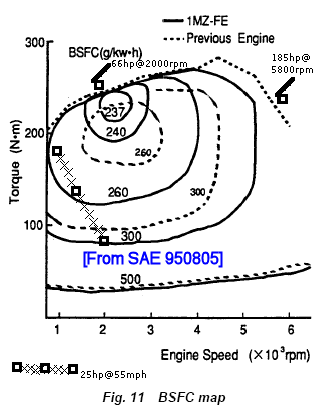  Bill in Houston Yep! Bill in Houston Yep! 06-22-2007, 12:27 PM
|
 06-22-2007, 12:27 PM
06-22-2007, 12:27 PM
|
#1
|
|
Registered Member
Join Date: Mar 2007
Posts: 1,138
|
Yep!
__________________

|

|

|
 06-22-2007, 01:21 PM
06-22-2007, 01:21 PM
|
#2
|
|
Registered Member
Join Date: Mar 2007
Posts: 191
|
So in the actual car case, however, the argument won't work though, since the efficiencies at the various loads are going to be pretty much the same. The acceleration loads are always at worst efficiency.
So take the 2000 lb car with one pulse and glide. It takes some 1/2mV*V of energy to get to speed, after which you will glide some distance d. The 1000 lb car will take half of the energy to get to speed, and will glide some distance less than d, (but not necessarily half of d... or will it)???
This describes an easy test I think. If you halve the weight, you can do two pulse and glides for the price of one. Which of these cases allows you to travel farther? It only works if the heavier car goes futher in one P&G than the lighter car does in two.
|

|

|
 06-22-2007, 01:59 PM
06-22-2007, 01:59 PM
|
#3
|
|
Registered Member
Join Date: Mar 2007
Posts: 1,138
|
Quote:
Originally Posted by lca13

So in the actual car case, however, the argument won't work though, since the efficiencies at the various loads are going to be pretty much the same. The acceleration loads are always at worst efficiency.
|
I think that this is the problem. Efficiencies vary quite a bit. A lot more than I would have expected. And in ways I would not have expected. Have a look at this chart.
 If you can operate at 237 vs 300 or 400 or 500, then you can get your kinetic energy by burning less gas.
__________________

|

|

|
 06-22-2007, 02:14 PM
06-22-2007, 02:14 PM
|
#4
|
|
Supporting Member
Join Date: Jun 2007
Posts: 348
|
You may be able to "never hit the brakes" in theory but when a gust of wind sets you back all the same, you are having to regain 4800lbs worth of momentum in the heavier element. Same gust of wind and you only have to accelerate 200lbs in the lighter. You can what if the road was 0 friction all day and still the lighter car is going to win in theory. Someone is going to read this thread and start telling people that they read on gassavers that you can "in theory" get better gas mileage in a heavier car in the mountains.
|

|

|
 06-22-2007, 03:51 PM
06-22-2007, 03:51 PM
|
#5
|
|
Registered Member
Join Date: Mar 2007
Posts: 1,138
|
Quote:
Originally Posted by 88HF

You may be able to "never hit the brakes" in theory but when a gust of wind sets you back all the same,
|
A gust of wind DOESN'T set you back all the same. The heavy one will not be slowed as much as a light one. That's part of the point.
__________________

|

|

|
 06-22-2007, 01:22 PM
06-22-2007, 01:22 PM
|
#6
|
|
Team GasMisers5!
Join Date: Nov 2006
Posts: 440
|
PS for electric motor cars, the lighter the better! The above discussion is only regarding internal combustion engines which work more efficiently at greater load (to a point).
__________________
   Team GasMisers5 - #1 for first three rounds of the original GS Fuel Economy Challenge
Team GasMisers5 - #1 for first three rounds of the original GS Fuel Economy Challenge
Miles displaced by e-bike since 1 Jan 2008: 62.6 ( 0 kWh used)
Hypomiler 
|

|

|
 06-22-2007, 01:32 PM
06-22-2007, 01:32 PM
|
#7
|
|
Team GasMisers5!
Join Date: Nov 2006
Posts: 440
|
Back to my original argument.
(1) Start by realising that pulse-and-glide is the most efficient driving technique on flat ground.
Get three identical cars (e.g. Honda Accords).
One of them has been modified, and weighs 1 gram.
One of them is 'normal' in weight
One of them has been modified, and weighs 10 tons.
The 1 gram one is not that efficient. You have to stay in gear all the time, so get a lot of engine drag. If you go into neutral, aero drag stops the car in about 0.1ms 
The 'normal' one lets you pulse and glide -> the most efficient one
The 10 ton one is not that efficient, because the rolling resistance is too high.
So, somewhere between 1 gram and 10 tons, there is a 'sweet spot'. It is probably not at the weight of the 'normal' one, although that one is closer.
If you use an electric motor in your car, then the ligher the better, because the efficiency is (pretty much) constant, and so you just want to reduce RR and aero drag as much as possible to get more efficiency.
__________________
   Team GasMisers5 - #1 for first three rounds of the original GS Fuel Economy Challenge
Team GasMisers5 - #1 for first three rounds of the original GS Fuel Economy Challenge
Miles displaced by e-bike since 1 Jan 2008: 62.6 ( 0 kWh used)
Hypomiler 
|

|

|
 06-22-2007, 02:47 PM
06-22-2007, 02:47 PM
|
#8
|
|
Registered Member
Join Date: Mar 2007
Posts: 191
|
Yeah, I know, this is desperately starting to sound like a perpetual motion argument. Sure a 100 HP engine in a 50 lb car probably won't do any better than in a 100 lb car, because the waste energy is large WRT to energy expended for motion, and the 100 car might do better using P&G for that reason.
But at some point.... some point lower than I believe most here are thinking, the return on investment starts following the linear degradation curve.
Does anyone really think that shaving 500 lbs off their car will hurt mileage?
Bill, I agree with your chart, but that is not the same as taking the same engine, chassis, transmission, final drive, etc and changing the mass around it.
Gads, I am sure this can be show mathematically, its just that it has been a while and when one is away from that stuff, one usually gets it wrong on the attempts rather than right :-(
|

|

|
 06-22-2007, 02:51 PM
06-22-2007, 02:51 PM
|
#9
|
|
Registered Member
Join Date: Mar 2007
Posts: 191
|
Another real world consideration is that real driving can never be pure pulse and glide... there will be some amount of steady state, engine load cruising, and don't think for a minute that you are maintaining a stead speed. Instead you are constantly accelerating and decelerating around your target speed, and because you are not 100% efficient in gasoline PE to KE conversion, you continually lose in direct proportion to your mass.
|

|

|
 06-22-2007, 05:26 PM
06-22-2007, 05:26 PM
|
#10
|
|
Registered Member
Join Date: Jun 2007
Posts: 8
|
Has anyone ever racer a derby car in the boy scouts? the cars are all the same weight and depending on the design of the car and where the weight is placed each car will travel at different speeds down an incline, some much faster than others but all weighing the same.
|

|

|
 |
|
| Thread Tools |
|
|
| Display Modes |
 Hybrid Mode Hybrid Mode
|
 Posting Rules
Posting Rules
|
You may not post new threads
You may not post replies
You may not post attachments
You may not edit your posts
HTML code is Off
|
|
|
|
 » Car Talk & Chit Chat
» Car Talk & Chit Chat |
|
|
|
|
|
|
|
|
|
|
 » Fuelly iOS Apps
» Fuelly iOS Apps |
|
No Threads to Display.
|
 » Fuelly Android Apps
» Fuelly Android Apps |
|
|
|
